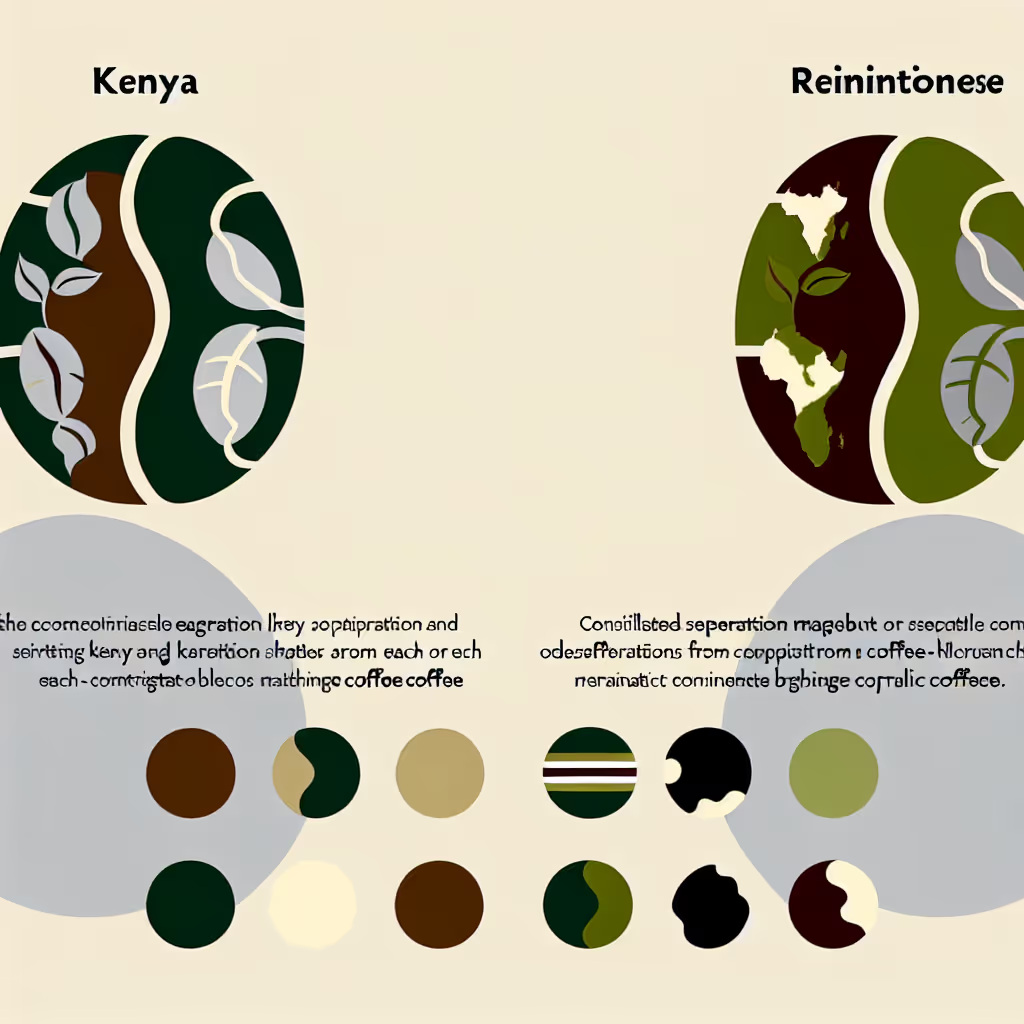Kenyan Vs. New Caledonian Coffee
This comparison explores the distinct qualities of Kenyan and New Caledonian coffees, highlighting their unique flavor profiles, growing conditions, and cultural significance for coffee enthusiasts and buyers.

Brief Description
Kenyan coffee is renowned for its bright acidity, full body, and complex flavor profile. Grown in the rich volcanic soils of the Central Highlands, these beans benefit from ideal climate conditions and meticulous processing. The result is a cup that's bold, wine-like, and often described as the 'connoisseur's choice'. With notes ranging from blackcurrant to citrus, Kenyan coffee offers a truly unique and memorable tasting experience.
New Caledonian coffee is a hidden gem in the Pacific, grown on the main island of Grande Terre. This unique origin offers a blend of French colonial influence and Melanesian traditions, resulting in a coffee with distinctive character. The tropical climate and volcanic soils contribute to a cup profile that's both exotic and familiar, with notes that surprise and delight coffee enthusiasts seeking new experiences.
Importance of Comparison
Comparing Kenyan and New Caledonian coffee origins is crucial for coffee lovers seeking to expand their palate and understand the nuances of global coffee production. These two origins represent vastly different growing regions, processing methods, and flavor profiles, offering insights into how geography and culture influence coffee characteristics. By exploring these contrasts, consumers can make informed decisions about their coffee purchases and appreciate the diversity of the coffee world.
Key Attributes
Origin
Kenyan
New Caledonian


Consumer Guide
When choosing between Kenyan and New Caledonian coffee, consider your flavor preferences and brewing methods. Kenyan coffee, known for its bright acidity and complex profile, excels in pour-over and French press brewing, highlighting its blackcurrant and citrus notes. It's ideal for those who enjoy a bold, wine-like cup. New Caledonian coffee, with its chocolate and nutty undertones, performs well in French press and espresso preparations, offering a more subtle and exotic experience. Consider the altitude difference: Kenyan beans grow at 1400-2100m, while New Caledonian coffee thrives at 300-800m, affecting flavor development. Kenyan coffee's larger production (50,000 metric tons annually) means greater availability, while New Caledonia's limited output (150 metric tons) offers exclusivity. Choose Kenyan for a classic, full-bodied experience, or New Caledonian for a unique, Pacific-influenced cup.
Expert Opinions
Coffee expert Maria Rodriguez notes, 'Kenyan coffee represents the pinnacle of East African production, with its unmistakable brightness and complexity. New Caledonian coffee, while less known, offers a fascinating blend of Pacific terroir and French colonial influence.' Roaster John Smith adds, 'The double fermentation process often used in Kenya creates a cleaner, more vibrant cup compared to New Caledonia's varied processing methods. However, New Caledonian coffee's lower altitude growth results in a smoother, less acidic profile that many find approachable.'
FAQs
Kenyan coffee is known for its bright acidity with prominent blackcurrant, citrus, and floral notes, resulting in a bold, wine-like flavor. New Caledonian coffee offers a more subtle profile with chocolate, citrus, and nutty undertones, reflecting its unique Pacific island terroir and lower altitude growth.
Kenyan coffee excels in pour-over, French press, and cold brew methods, which highlight its complex acidity and full body. New Caledonian coffee performs well in French press, pour-over, and espresso preparations, showcasing its smooth, nuanced flavors. Both origins are versatile, but these methods tend to bring out their best characteristics.
Kenyan coffee grows at higher altitudes (1400-2100m), contributing to its bright acidity and complex flavor profile. New Caledonian coffee, grown at lower altitudes (300-800m), develops a smoother, less acidic taste with more subtle flavor notes. The altitude difference significantly influences the beans' density and flavor development during growth.
Kenyan coffee often undergoes a unique double fermentation process, followed by sun-drying, which enhances its clean, bright flavor profile. New Caledonian coffee uses a variety of processing methods including washed, natural, and semi-washed, offering more diversity in flavor outcomes. These distinct approaches reflect each region's traditions and environmental conditions.
Kenya produces approximately 50,000 metric tons of coffee annually, making it a significant player in the global coffee market. In contrast, New Caledonia's annual production is much smaller at around 150 metric tons. This vast difference in output affects availability, with Kenyan coffee being more widely accessible and New Caledonian coffee offering a more exclusive, boutique experience.
Kenyan coffee production is deeply rooted in East African coffee traditions, with a focus on quality and cooperative farming systems. New Caledonian coffee reflects a unique blend of French colonial influence and Melanesian traditions, resulting in a distinctive approach to cultivation and processing that sets it apart in the Pacific coffee scene.
Conclusion
Comparing Kenyan and New Caledonian coffee reveals a fascinating contrast in the world of specialty coffee. Kenyan beans offer a bold, complex experience with bright acidity and distinctive flavors, ideal for those seeking a classic, full-bodied cup. New Caledonian coffee presents a more subtle, exotic profile, appealing to adventurous coffee enthusiasts looking for unique tastes. While Kenyan coffee is more widely available and recognized, New Caledonian beans offer exclusivity and a taste of Pacific island terroir. Ultimately, the choice between these origins depends on personal taste preferences, desired brewing methods, and the coffee experience you're seeking. Both offer high-quality, distinctive cups that showcase the diversity and richness of global coffee production.





